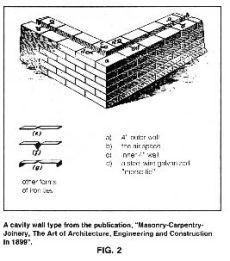Brick walls used to be built two bricks widths deep. This made for a strong, stable wall. Now they are made one width deep. What changed?
While it is true that most brick walls are only one brick deep there is a good reason for this. It isn’t just the economics of using half as many bricks.
With the modern brick wall there is an interior wall, usually of block or poured concrete. If the bricks are just mortared onto the inner wall like tile than this is known as an adhered brick siding or veneer. There is another option, known as an anchored brick siding.
With the old-style of brick wall water would penetrate the wall through cracks in the mortar. Eventually cracks always form. Even where they aren’t visible water can penetrate to the interior of the wall where the water can lead to wood rot or rusting metal, mildewed walls and wet floors. With luck the water is visible and apparent and the leaks are fixed. If the water penetration isn’t caught it eventually causes thousands or tens of thousands of dollars in damage.

Construction guide from 1899 detailing a cavity wall.
With a brick cavity wall there is an air gap between the interior brick surface and the block or concrete of the interior wall. Any water that penetrates to this gap will trickle down to the bottom of this air gap where it will exit out through weep holes in the mortar. This means you can have a brick exterior without having water leaking into your house.
Since the brick wall is only one brick width deep it can’t be very stable. To fix this deficiency the brick is tied into the interior block wall with stamped metal ties. This system is actually quite old but they originally used extra long bricks, rather than metal stampings, to tie an outer brick wall to an inner brick wall. Now the bricks only form the outer wall.
The downside is aesthetic. When walls were made of bricks that interlocked in two directions you had a wider variety of patterns. Now almost everything is a running bond. You only see bricks from the side view not the end view. You can still recreate any of the bond patterns, but it requires cutting bricks in half. This is an added expense and most builders don’t think that their customers are willing to fork over the extra money for the fancier bond.
Alternatively you could build a traditional brick wall and an interior brick wall and achieve the same effect. However that doubles the number of bricks without bringing any additional functionality, so this process is rarely used.
Brick veneer isn't the only siding option, for more information you can read up on all the different types of exterior siding.
Category:



